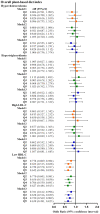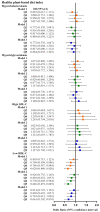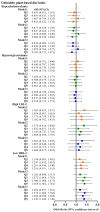Association between Different Types of Plant-Based Diets and Dyslipidemia in Middle-Aged and Elderly Chinese Participants
- PMID: 36615887
- PMCID: PMC9823762
- DOI: 10.3390/nu15010230
Association between Different Types of Plant-Based Diets and Dyslipidemia in Middle-Aged and Elderly Chinese Participants
Abstract
Plant-based dietary patterns may reduce the risk of dyslipidemia. However, not all plant-based foods are beneficial, and limited data exist for the Chinese population. We investigated the association between different plant-based dietary indices and the risk of dyslipidemia in a Chinese middle-aged and elderly population. The study participants (n = 4096) consisted of adults between 35 and 74 years of age from Xinjiang, China. Dietary consumption of the study participants was evaluated using a semi-quantitative food-frequency questionnaire (FFQ). Three different plant-based dietary indices were calculated using data from dietary surveys, including overall plant-based diet index (PDI), healthy plant-based diet index (hPDI), and unhealthy plant-based diet index (uPDI). Based on these indices, we created an adjusted plant-based diet index (aPDI) based on the Xinjiang population actual dietary behavior and health effects of food. We measured the levels of total cholesterol, triglyceride, LDL-C, and HDL-C in the blood of the study participants. We used multivariable logistic regression and restricted cubic spline to analyze the relationship between plant-based diets and dyslipidemia. The findings showed that 36.6% of the participants had dyslipidemia. Higher PDI adherence was related to lower odds of dyslipidemia (Q3 vs. Q1, OR: 0.780, 95% CI: 0.641-0.949; Q4 vs. Q1, OR: 0.799, 95% CI: 0.659-0.970). High aPDI was related to lower odds of dyslipidemia (Q4 vs. Q1, OR: 0.770, 95% CI: 0.628-0.945; Q5 vs. Q1, OR: 0.748, 95% CI: 0.607-0.921). High scores for PDI, hPDI, and aPDI were all related to a reduced risk of low HDL-C (OR: 0.638, 95% CI: 0.491-0.823; OR: 0.661, 95% CI: 0.502-0.870; OR: 0.580, 95% CI: 0.443-0.758). Conversely, a high uPDI score was associated with an increased risk of low HDL-C (OR: 1.349, 95% CI: 1.046-1.740). There was no non-linear relationship between PDI, hPDI, uPDI, and aPDI and the risk of different types of dyslipidemia. Plant-based dietary indices are related to specific types of dyslipidemia risk. Appropriately increasing the consumption of plant-based foods while improving the quality of plant-based dietary patterns is critical for the prevention of dyslipidemia, especially low HDL-C, in the population.
Keywords: dyslipidemia; middle-aged and elderly Chinese; plant-based dietary patterns; plant-based-food quality.
Conflict of interest statement
The authors declare no conflict of interest.
Figures





Similar articles
-
Association between Unhealthful Plant-Based Diets and Possible Risk of Dyslipidemia.Nutrients. 2021 Nov 30;13(12):4334. doi: 10.3390/nu13124334. Nutrients. 2021. PMID: 34959886 Free PMC article.
-
Plant-based diet quality and the risk of total and disease-specific mortality: A population-based prospective study.Clin Nutr. 2021 Dec;40(12):5718-5725. doi: 10.1016/j.clnu.2021.10.013. Epub 2021 Oct 25. Clin Nutr. 2021. PMID: 34749131
-
Association between Different Types of Plant-Based Diets and Risk of Dyslipidemia: A Prospective Cohort Study.Nutrients. 2021 Jan 14;13(1):220. doi: 10.3390/nu13010220. Nutrients. 2021. PMID: 33466664 Free PMC article.
-
Scoping review of the association of plant-based diet quality with health outcomes.Front Nutr. 2023 Aug 10;10:1211535. doi: 10.3389/fnut.2023.1211535. eCollection 2023. Front Nutr. 2023. PMID: 37637943 Free PMC article.
-
Associations between plant-based diets and cardiovascular disease, frailty, and cognitive dysfunction in middle and old age: a systematic review and meta-analysis of cohort studies.Food Funct. 2025 May 19;16(10):4061-4084. doi: 10.1039/d4fo03384a. Food Funct. 2025. PMID: 40298944
Cited by
-
A plant-based diet index to study the relation between diet and disease risk among adults: a narrative review.J Nutr Health Aging. 2024 Jun;28(6):100272. doi: 10.1016/j.jnha.2024.100272. Epub 2024 May 29. J Nutr Health Aging. 2024. PMID: 38815475 Free PMC article. Review.
References
-
- Atar D., Jukema J.W., Molemans B., Taub P.R., Goto S., Mach F., CerezoOlmos C., Underberg J., Keech A., Tokgözoğlu L., et al. New cardiovascular prevention guidelines: How to optimally manage dyslipidaemia and cardiovascular risk in 2021 in patients needing secondary prevention? Atherosclerosis. 2021;319:51–61. doi: 10.1016/j.atherosclerosis.2020.12.013. - DOI - PubMed
-
- Lu Y., Zhang H., Lu J., Ding Q., Li X., Wang X., Sun D., Tan L., Mu L., Liu J., et al. Prevalence of Dyslipidemia and Availability of Lipid-Lowering Medications Among Primary Health Care Settings in China. JAMA Netw. Open. 2021;4:e2127573. doi: 10.1001/jamanetworkopen.2021.27573. - DOI - PMC - PubMed
MeSH terms
Grants and funding
LinkOut - more resources
Full Text Sources

